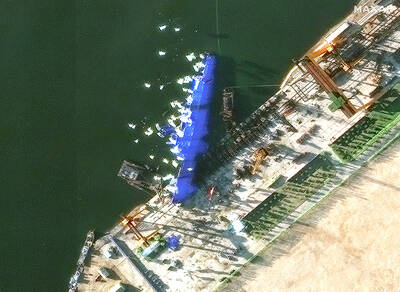The Philippines on Sunday evening issued a formal diplomatic protest to China after hundreds of fishing vessels were spotted at a disputed reef in the South China Sea.
About 220 Chinese vessels were seen moored in line at Whitsun Reef in the South China Sea on March 7, a Philippine government task force overseeing the disputed waters said in a statement on Saturday.
The vessels’ presence is “a concern due to the possible overfishing and destruction of the marine environment, as well as risks to safety of navigation,” the Philippine government statement said.
The area, which Manila calls Julian Felipe, is a large but shallow, boomerang-shaped coral reef within the Philippines’ exclusive economic zone, the task force said.
A diplomatic protest was “fired off tonight,” Philippine Secretary of Foreign Affairs Teodoro Locsin wrote on Twitter.
China was deploying “numerous ships into the area and stationing them at strategic locations, ready to be called upon to participate in any operations it may wish to carry out against any other countries,” said Jay Batongbacal, director of the University of the Philippines’ Institute for Maritime Affairs and Law of the Sea.
“These operations can cover everything from surveillance to forcing unilateral exploitation of resources to wresting islands away from other nations,” Batongbacal added. “Whether this particular deployment of vessels on Whitsun Reef is preparatory to another specific operation, we have yet to see.”
Philippine presidential spokesman Harry Roque yesterday played down the possibility of any escalation similar to one in 2012 when the Philippine Navy apprehended a group of Chinese fishing frigates at the Scarborough Shoal (Huangyan Island, 黃岩島), which is also claimed by Taiwan.
“We have a close friendship. Everything can be discussed between friends and neighbors,” Roque said in a televised media briefing.

Four people jailed in the landmark Hong Kong national security trial of "47 democrats" accused of conspiracy to commit subversion were freed today after more than four years behind bars, the second group to be released in a month. Among those freed was long-time political and LGBTQ activist Jimmy Sham (岑子杰), who also led one of Hong Kong’s largest pro-democracy groups, the Civil Human Rights Front, which disbanded in 2021. "Let me spend some time with my family," Sham said after arriving at his home in the Kowloon district of Jordan. "I don’t know how to plan ahead because, to me, it feels

‘A THREAT’: Guyanese President Irfan Ali called on Venezuela to follow international court rulings over the region, whose border Guyana says was ratified back in 1899 Misael Zapara said he would vote in Venezuela’s first elections yesterday for the territory of Essequibo, despite living more than 100km away from the oil-rich Guyana-administered region. Both countries lay claim to Essequibo, which makes up two-thirds of Guyana’s territory and is home to 125,000 of its 800,000 citizens. Guyana has administered the region for decades. The centuries-old dispute has intensified since ExxonMobil discovered massive offshore oil deposits a decade ago, giving Guyana the largest crude oil reserves per capita in the world. Venezuela would elect a governor, eight National Assembly deputies and regional councilors in a newly created constituency for the 160,000

North Korea has detained another official over last week’s failed launch of a warship, which damaged the naval destroyer, state media reported yesterday. Pyongyang announced “a serious accident” at Wednesday last week’s launch ceremony, which crushed sections of the bottom of the new destroyer. North Korean leader Kim Jong-un called the mishap a “criminal act caused by absolute carelessness.” Ri Hyong-son, vice department director of the Munitions Industry Department of the Party Central Committee, was summoned and detained on Sunday, the Korean Central News Agency (KCNA) reported. He was “greatly responsible for the occurrence of the serious accident,” it said. Ri is the fourth person

At a calligraphy class in Hanoi, Hoang Thi Thanh Huyen slides her brush across the page to form the letters and tonal marks of Vietnam’s unique modern script, in part a legacy of French colonial rule. The history of romanized Vietnamese, or Quoc Ngu, links the arrival of the first Christian missionaries, colonization by the French and the rise to power of the Communist Party of Vietnam. It is now reflected in the country’s “bamboo diplomacy” approach of seeking strength through flexibility, or looking to stay on good terms with the world’s major powers. A month after Chinese President Xi Jinping (習近平) visited,